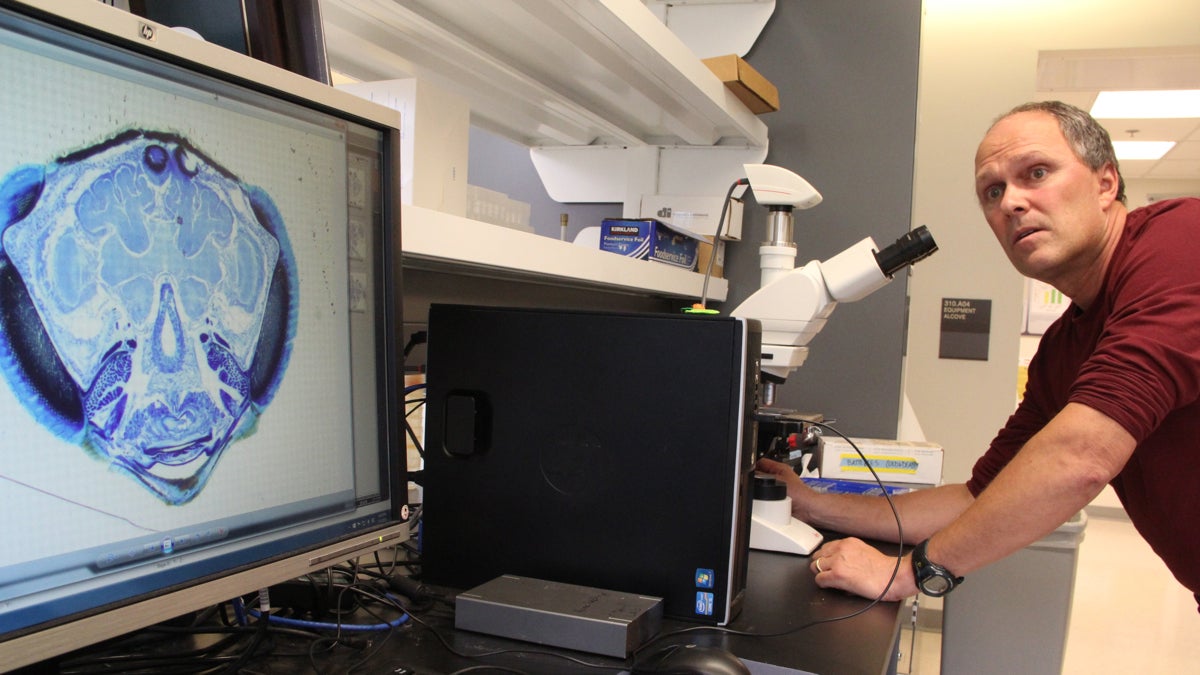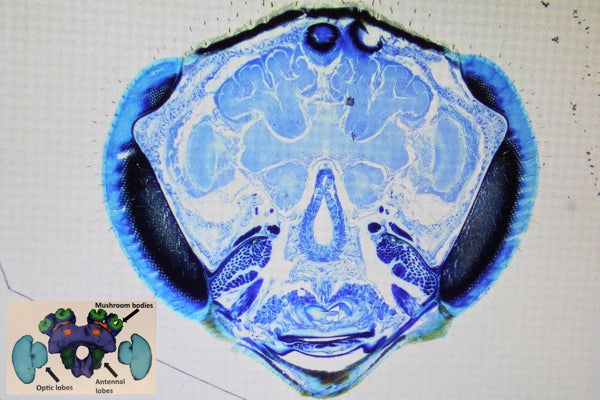How social societies may play a role in insect brain size
Listen
Drexel Professor Sean O'Donnell brings up a cross section of the brain of a social wasp. (Emma Lee/WHYY)
Scientists have long been fascinated by how insects, tiny animals with even tinier brains, coordinate complex group actions.
Colonies of weaver ants, for example, form living ladders with their bodies to knit together nests of hanging leaves.
New research out of Drexel University in Philadelphia supports the idea that wasp colonies share a kind of distributed brain, allowing each individual wasp to cash in on the combined intelligence of its nest.
Theory of the ‘social brain’
The story of these wasps, or why we care about them at least, starts with the story of us.
Primates, including monkeys, apes and humans, all have brains that are much larger than those of most mammals in comparison to body size. Brain tissue takes a lot of energy to make and maintain, which has led scientists to ask a central question about primate evolution:
“The question is, why?” said Robert Seyfarth, a psychology professor at the University of Pennsylvania, who studies the social behavior of monkeys in Africa.
“What are these big brains doing, what do you get for having a bigger brain?”
One way to understand why primate brains evolved to be so large, Seyfarth said, is to look at how they live. Take chimpanzees, for example.
“These animals live their entire lives in highly complex social groups where animals form alliances, it’s very much like a Jane Austen novel,” Seyfarth said.
It’s a competitive, hierarchical society, formed from a mix of related and unrelated chimps.
“You’ve got animals that are higher ranking, lower ranking, and these shifting alliances all present animals with an extremely complicated social problem,” Seyfarth said.
The problem is figuring out and remembering who’s allies with whom, and who’s still available for you to ally with, to help you raise your kid or forage for food or warn you if a predator is nearby.
Social life for many primates and other mammals grew more and more complex over time.
As it did, “natural selection favored animals who could solve the problems posed by this complexity,” Seyfarth said. “That is, animals with bigger brains.”
Seyfarth cites as an example Lucy, a skeleton of one of the earliest human ancestors ever found.
She lived 3.2 million years ago, and had a brain about the size of a chimpanzee’s, less than a third of the size of a modern human brain.
Primate brain growth has been most pronounced in the frontal cortex, and especially explosive in humans and their predecessors.
Since social complexity was first linked to large brain size decades ago, the connection between brain size and social networks has been confirmed in a variety of large mammals.
Today, primate scholars say brains probably evolved to deal with both social and non-social problems, but this so-called “social brain hypothesis” remains a leading theory explaining the evolution of primate brains.
An opposite theory for invertebrates
Invertebrates, however, were another story.
“We really didn’t know what was happening with insect societies,” said Drexel University professor Sean O’Donnell.
Research published about five years ago showed that large brain size in insects evolved long before big social societies were formed. That, and other research from around the same time, suggested that the social brain hypothesis may not hold true for invertebrates and prompted a wave of research into the question.
As part of that research, Sean O’Donnell and his collaborators started collecting wasps from around the world to study their brains several years ago. In a paper published this summer in a journal of The Royal Society in London, his team compared a portion of the brain in six species of solitary wasps to 23 species of wasps that live in colonies.
“What we found, to our surprise, was that not only did the insect not match the vertebrate pattern, they actually showed exactly the opposite pattern,” O’Donnell said.
The portion of the brain responsible for complex cognition in insects was smaller in wasps that lived in colonies than those that lived on their own.
 Research shows that the mushroom bodies in the brains of social wasps are consistently smaller than those in the brains of non-social wasps. (Emma Lee/WHYY)
Research shows that the mushroom bodies in the brains of social wasps are consistently smaller than those in the brains of non-social wasps. (Emma Lee/WHYY)
O’Donnell thinks this difference between vertebrates and invertebrates, or wasps at least, can be explained by how their societies are formed.
“Basically a wasp society starts off with a single female founding a new colony and then having a bunch of offspring that then stick around at home and help her rear further sets of offspring,” O’Donnell said. “The colony grows basically like a family grows.”
This giant, genetically related family unit works more cooperatively than primate societies, without all the complicated shifting alliances of an episode of ‘Survivor’.
“If the larvae are hungry and demanding food, if the nest is damaged and you need to collect materials to repair it, you don’t necessarily have to figure that out or perceive that on your own,” O’Donnell said of social wasps.
O’Donnell sees these tightly related wasp colonies as a kind of extended nervous system. Each wasp shares in the “distributed cognition” of the nest, so each individual wasp brain can afford to be smaller.
Contrast that to the experience of a solitary wasp, O’Donnell said.
“She needs to assess all of those demands and all of those needs and solve all of those problems herself.”
Her brain needs to be bigger.
O’Donnell’s research suggest how societies form and what they look like – not just that they exist – are important in understanding how they influence individual brains.
Possible implications for human brain evolution
Boston University biology professor James Traniello, who does similar research on ants, takes this finding one step further.
He believes the idea of distributed intelligence in insects may help explain an aspect of the evolution of the human brain.
“Most people are aware that over the last 200,000 years, human brains have increased very dramatically,” Traniello said.
What’s less well-known, Traniello said, is that starting about 10,000 to 20,000 years ago, around the time agricultural societies began to develop, human brains started to shrink. According to one estimate, they have lost about the size of a tennis ball so far.
“That is as fascinating as why human brains became large in the first place,” Traniello said.
Human bodies started to get smaller around the same time in our evolutionary history, which could help explain this brain shrinkage, but Traniello believes there is more to it than that.
“We think that social insects give us a great opportunity to try to address that question,” Traniello said.
He hypothesizes that human brains, just like insects, started to lose mass as our increasingly complex societies began to make decisions collectively.
“It’s like the society is thinking for the individual, and therefore, you don’t need as much neural tissue to make such decisions, because they’re being made at a different level through a different mechanism,” Traniello said.
This parallel between insect and human brain evolution is a theory Traniello is researching by looking at ants, humans, and naked mole rats, which live in insect-like societies.
While he does, he likes to think about how our brains will change over the next several thousand years, as more of the memory and problem solving functions that our brains used to do are taken over by the cloud.
WHYY is your source for fact-based, in-depth journalism and information. As a nonprofit organization, we rely on financial support from readers like you. Please give today.



